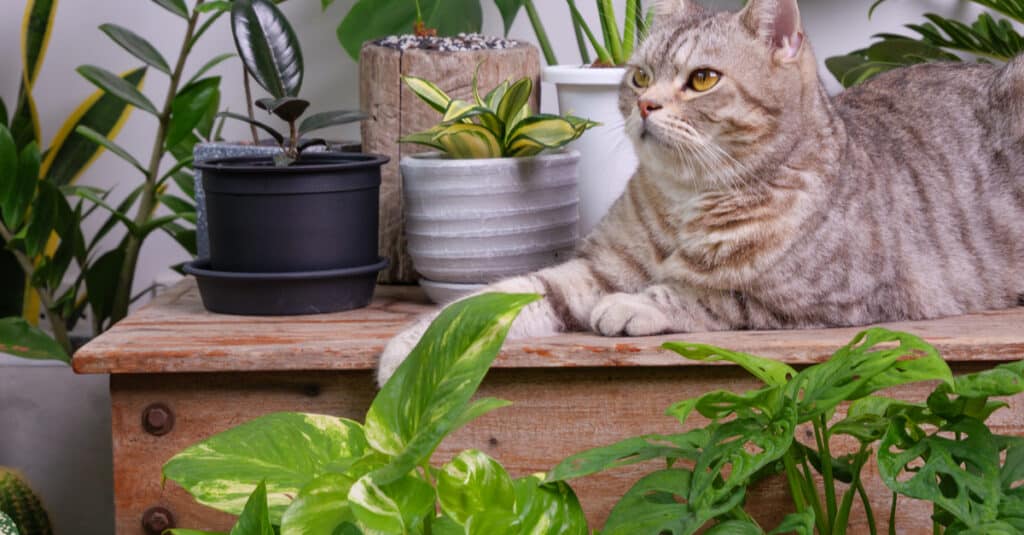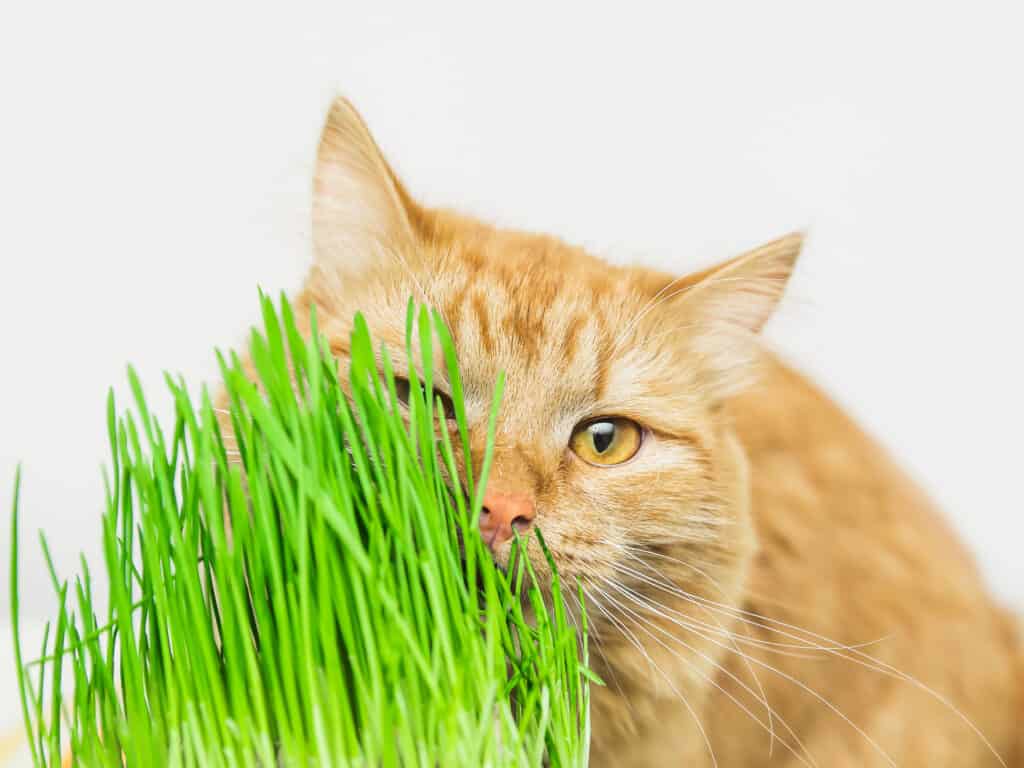You’ve noticed a couple of disturbed leaves on your house plants. Upon closer inspection, you realize they’re bite marks. On the one hand, you’re relieved because you’re not dealing with common pests. But on the other hand, you realize you have identified the culprit. Your beloved kitty! Discover seven clever and effective ways to keep your cat out of the house plants! Plus, learn why cats engage in this behavior and which common house plants are actually toxic to cats!
Why Do Cats Eat Houseplants?
Cats eat houseplants out of simple curiosity. If it’s just a nibble here and there, they’re just checking out the addition to their home environment. Even in the wild, cats sometimes munch on leaves or grass because it’s beneficial for their digestive system. If it is more than a curious nibble, then they may be displaying this behavior due to stress. Anxiety manifests itself in various ways. If you notice your cat is consistently eating your house plants, it is worth looking into to uncover the underlying reasons for your cat’s stress.

Cats may eat house plants out of curiosity, to aide digestion, or if stressed.
©Foto2rich/Shutterstock.com
7 Clever and Effective Ways to Keep Your Cat Out of the Houseplants
1. Make Your Plants Gross to Cats
To prevent your kitty from getting to your plants, make them gross! Without harming your plants. For example, you can spray lemon or lime juice diluted in water on the leaves. See if they dislike citrus. If the aroma is not bad enough for them, they will still lean in and give it a taste. Once they do, that should be sufficient for them not to return.
Additionally, there is a long list of plants that can serve as a natural deterrent to cats. For example, you can have a rosemary plant. Be mindful of the plants you select to have in the home as several types can be toxic to your feline friend. If you regularly keep lemons at home, take advantage of the peels. Instead of throwing them away, you can use them in your plant beds or put a few in your house plants — this is another method of adding citrus and making plants gross to your kitty.
2. Invest Time in Training
Training is not just for pups! Cats learn at a different pace than dogs, however. They are not as quick because they’re not as eager. But you can use positive reinforcement when your kitty displays positive behavior. Don’t punish your cat for unwanted behavior — this tactic does not work and only leads to a stressed-out and fearful kitty.
Remember, a highly stressed cat can get to some serious munching on your house plants, which just creates an unfavorable cycle all around. Engaging cats at a very young age in social gatherings with other animals and other people is a stimulus that they need and can be very rewarding. This allows them to become well-adjusted adults and more resilient, which means less stress and stress-related behaviors.
3. Try Aluminum Foil
Kitties dislike the sound of aluminum foil when they step on it. Try placing a sheet of it in areas where they like to go. Simply lining the table where your house plants are can train your kitty that those areas are off-limits. Aluminum foil is slippery so take out your double-sided tape and keep it secure. After several encounters, your kitty catches on. Eventually, you can remove the aluminum foil because your cat will have adjusted to the no-go areas.
4. Make Use of High Shelves
A cat tree makes up part of a cat’s comfortable home. They love climbing but be sure to place the cat tree and your house plants on opposite ends of your space. Your kitty can still enjoy the physical activity of climbing, it can cozy up on the tallest hammock, and appreciate your house plants from afar. If you don’t already have high shelves, set up some floating ones. Use these to place your house plants on. So long as there is nothing beneath where your kitty can climb and reach the leaves, your house plants will survive living with your tiny tyrant.
5. Provide Catnip or Cat Grass
Catnip and cat grass can provide the right kind of stimulation, which would rid you of your house plant-eating problem. Sometimes, their response is playful, and other times it’s a euphoric response. Eating catnip also helps to reduce stress, which can alleviate stress-related behaviors. Cat grass is fantastic for helping your kitty’s digestive system as well. If they’re eating your house plants for this purpose, you can provide them with a plant they can actually nibble on and enjoy the benefits of. You can also use catnip as a training tool to reward them with a sniff as positive reinforcement.

A little cat grass can go a long way!
©Irzhanova Asel/Shutterstock.com
6. Cage Your Plants
If the situation is bad enough, you can install chicken wire fences around your plants. Just keep in mind that they must be well-secured. This is an endeavor you can get creative with, especially if you have a knack for building things. But ultimately, by caging your plants, you offer them a protected place where they can thrive without your kitty interrupting their growth.
7. Create a Dedicated House Plant Room
Another alternative is to dedicate a space exclusively for your house plants like a sunroom. You can set them all up together, store your supplies nearby, and set up a cozy seating area. This cat-free zone allows your plants to flourish, especially if you’ve invested a long time into helping them grow. You won’t have to worry about your cat gaining access to the room, as it’ll be an unavailable access space for your cat.
Common Toxic Houseplants for Cats
Although house plants make beautiful additions to your home, there are some that are toxic to your kitty. Considering your kitty has been nibbling on them, it’s of extra importance that you remove any houseplants that may be toxic for cats. Below are some popular houseplants that don’t belong anywhere in a cat-friendly home.
Lilies
These flowers are stunning to admire and though they are aesthetically pleasing, they are entirely toxic to cats. Not just the flowers themselves but every portion of the plant, including the stems and leaves.
Snake Plants
Snake plants are other common house plants that are easy to maintain. While they help to improve the air quality in your home, they are toxic to cats. If you like the appearance, you might want to try incorporating a rattlesnake plant, which is not toxic to cats.
Pothos
This plant looks beautiful when hung from the ceiling but it’s also toxic for cats. Since it hangs low, it may be extra attractive to a cat, which would be unsafe. Reconsider placement of pothos, preferably in a dedicated house plant environment where your cat can never get in.
Aloe Vera
This plant has a host of benefits and it’s extremely easy to care for. Place your aloe vera plant on high shelves if you decide to keep one, ensuring your cat cannot climb nearby furniture to access it.
Tulips
Tulips make up part of the lily family and are also unfortunately toxic to cats. These are gorgeous flowers that could certainly be placed in an environment your cat can’t access but if your cat gets into them, they can get sick. This shows up as vomiting and diarrhea followed by depression. However, if they get ahold of the bulbs, the most toxic part of the flower, your cat may experience convulsions and cardiac issues.
The photo featured at the top of this post is © Viktor Sergeevich/Shutterstock.com
Thank you for reading! Have some feedback for us? Contact the AZ Animals editorial team.







